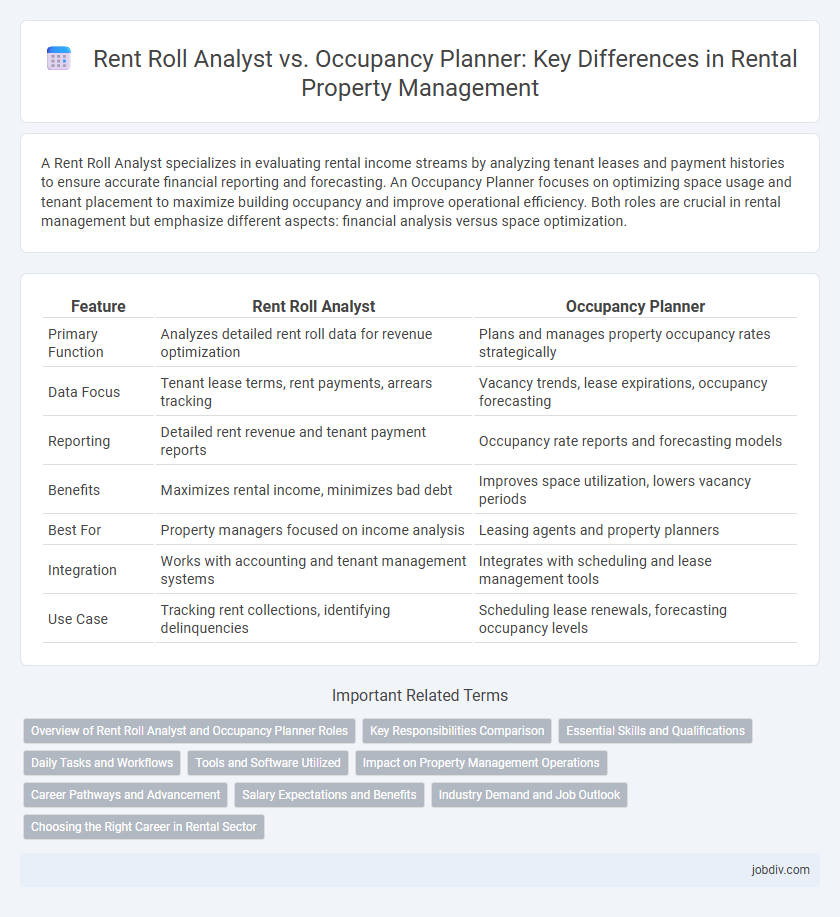A Rent Roll Analyst specializes in evaluating rental income streams by analyzing tenant leases and payment histories to ensure accurate financial reporting and forecasting. An Occupancy Planner focuses on optimizing space usage and tenant placement to maximize building occupancy and improve operational efficiency. Both roles are crucial in rental management but emphasize different aspects: financial analysis versus space optimization.
Table of Comparison
| Feature | Rent Roll Analyst | Occupancy Planner |
|---|---|---|
| Primary Function | Analyzes detailed rent roll data for revenue optimization | Plans and manages property occupancy rates strategically |
| Data Focus | Tenant lease terms, rent payments, arrears tracking | Vacancy trends, lease expirations, occupancy forecasting |
| Reporting | Detailed rent revenue and tenant payment reports | Occupancy rate reports and forecasting models |
| Benefits | Maximizes rental income, minimizes bad debt | Improves space utilization, lowers vacancy periods |
| Best For | Property managers focused on income analysis | Leasing agents and property planners |
| Integration | Works with accounting and tenant management systems | Integrates with scheduling and lease management tools |
| Use Case | Tracking rent collections, identifying delinquencies | Scheduling lease renewals, forecasting occupancy levels |
Overview of Rent Roll Analyst and Occupancy Planner Roles
A Rent Roll Analyst specializes in evaluating rental income streams, tenant lease details, and payment histories to optimize property revenue and identify financial risks. An Occupancy Planner focuses on forecasting space utilization, managing tenant occupancy rates, and developing strategies to maximize property occupancy and minimize vacancy periods. Both roles require detailed data analysis, but the Rent Roll Analyst leans towards financial assessment while the Occupancy Planner emphasizes space management and tenant retention strategies.
Key Responsibilities Comparison
Rent Roll Analysts focus on accurately tracking rental income, analyzing tenant payment patterns, and maintaining detailed records of lease agreements to optimize revenue flow. Occupancy Planners concentrate on forecasting space utilization, managing vacancy rates, and strategizing tenant placements to maximize property occupancy. Both roles are essential for balancing financial performance and tenant management in rental property operations.
Essential Skills and Qualifications
Rent Roll Analysts require strong analytical skills, proficiency in financial modeling, and expertise in data management to accurately track rental income and lease terms. Occupancy Planners must excel in strategic planning, space utilization analysis, and market trend forecasting to optimize property occupancy rates. Both roles demand attention to detail, knowledge of real estate software, and the ability to interpret market data for informed decision-making.
Daily Tasks and Workflows
Rent Roll Analysts meticulously review tenant payment histories and lease agreements to ensure accurate revenue tracking, analyze rent collections, and identify delinquencies. Occupancy Planners focus on optimizing space utilization by forecasting vacancy trends, coordinating leasing efforts, and managing tenant turnover schedules. Both roles require detailed data analysis and collaboration with property management, but Rent Roll Analysts emphasize financial accuracy while Occupancy Planners prioritize maximizing occupancy rates.
Tools and Software Utilized
Rent Roll Analysts typically utilize advanced property management software and data analytics platforms such as Yardi, MRI Software, and Excel for detailed financial reporting and cash flow analysis. Occupancy Planners rely heavily on occupancy tracking tools, CRM systems, and forecasting software like RealPage and CoStar to optimize lease renewals and minimize vacancy rates. Both professionals integrate GIS mapping and market trend databases to support strategic decision-making and enhance portfolio performance.
Impact on Property Management Operations
A Rent Roll Analyst drives property management operations by meticulously analyzing rental income streams, forecasting cash flows, and identifying discrepancies to optimize revenue collection and stabilize financial performance. An Occupancy Planner enhances operational efficiency by strategically managing tenant occupancy rates, balancing lease renewals, and minimizing vacancy periods to maximize asset utilization. Together, these roles contribute to improved financial health and streamlined property management workflows through data-driven decision-making and proactive operational strategies.
Career Pathways and Advancement
Rent Roll Analysts specialize in analyzing rental income streams and tenant payment histories, providing critical financial insights that support property management decisions. Occupancy Planners focus on optimizing space utilization and tenant mix to maximize occupancy rates and revenue generation. Career advancement for Rent Roll Analysts often leads to senior financial analyst or property portfolio management roles, while Occupancy Planners may progress into real estate development or strategic leasing director positions.
Salary Expectations and Benefits
Rent Roll Analysts typically earn between $55,000 and $75,000 annually, reflecting their expertise in financial data analysis and lease management within rental portfolios. Occupancy Planners command slightly higher salaries, ranging from $65,000 to $85,000, due to their strategic role in maximizing property utilization and forecasting tenant turnover. Benefits for both positions often include healthcare, performance bonuses, and professional development opportunities, with Occupancy Planners sometimes receiving additional incentives linked to occupancy rate improvements.
Industry Demand and Job Outlook
The demand for Rent Roll Analysts continues to grow in the real estate rental sector, driven by the need for accurate financial data analysis to optimize property revenue streams. Occupancy Planners are increasingly sought after to maximize tenant retention and space utilization, with a strong job outlook fueled by rising urbanization and changing rental market dynamics. Both roles offer promising career prospects, but Occupancy Planners may experience faster growth due to evolving tenant preferences and the strategic importance of space management.
Choosing the Right Career in Rental Sector
Rent Roll Analysts specialize in analyzing financial data, lease agreements, and tenant payment histories to optimize rental income, making them essential for investment-focused rental operations. Occupancy Planners concentrate on space utilization, tenant satisfaction, and forecasting demand to maximize property occupancy rates, enhancing operational efficiency. Selecting the right career depends on whether you prefer financial analytics and investment strategy or space management and tenant experience within the rental sector.
Rent Roll Analyst vs Occupancy Planner Infographic

 jobdiv.com
jobdiv.com